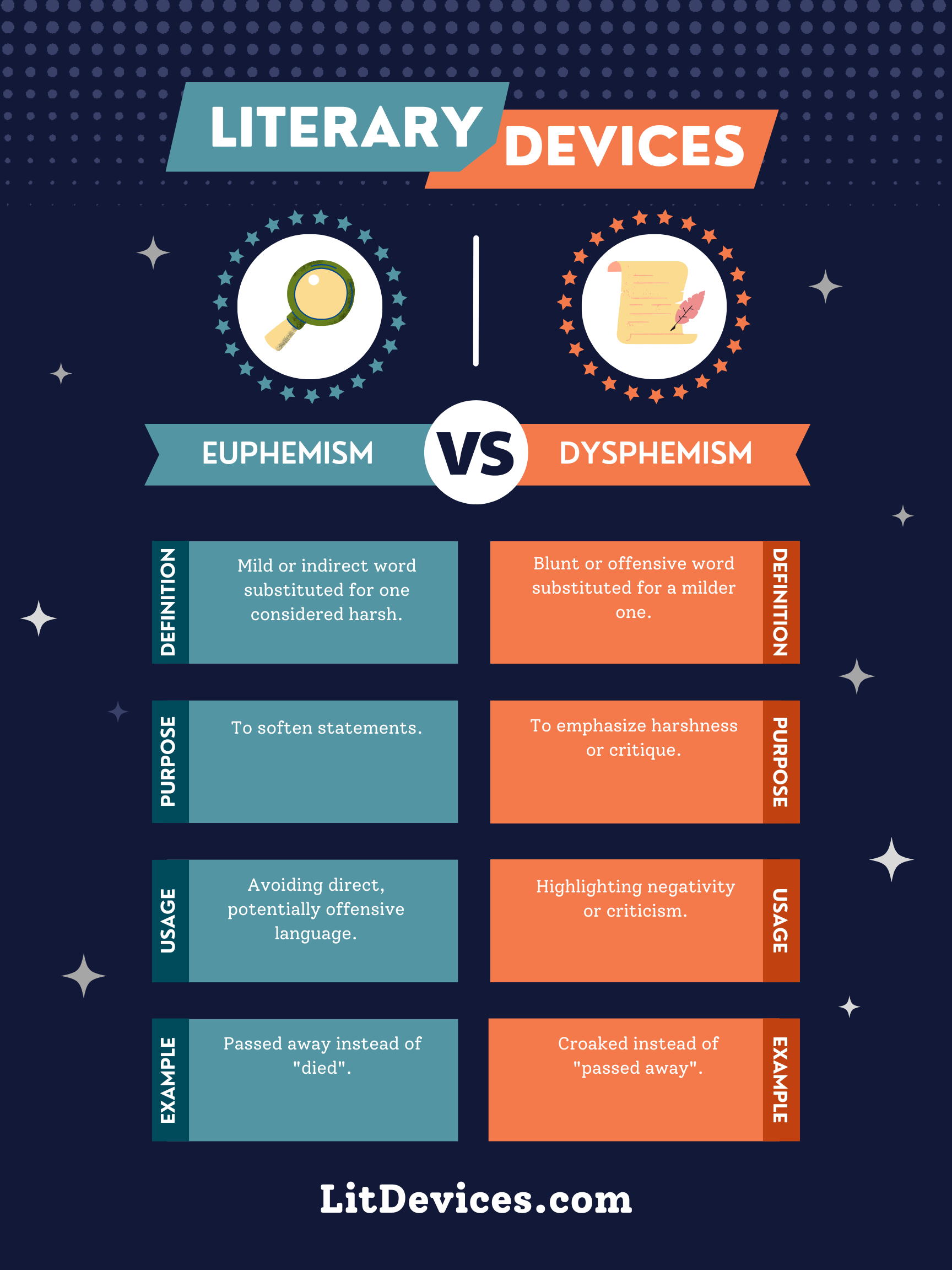Euphemism uses a milder or less harsh term instead of a direct, offensive one; Dysphemism is the use of an intentionally harsh word or expression instead of a polite one.
Euphemism
A euphemism is a polite, mild, or vague term used to replace a harsh, blunt, or offensive term. It’s often used to address sensitive subjects such as death, bodily functions, or social taboos, making the conversation more palatable or less uncomfortable.
🌼 Example: Saying “passed away” instead of “died” softens the harsh reality of death.
Dysphemism
Dysphemism, on the other hand, is the use of a blunt or direct term instead of a more polite or euphemistic one. It’s used to shock, offend, or convey disdain, often reflecting the speaker’s negative attitude towards the subject.
🔥 Example: Referring to someone as a “rat” instead of a “whistleblower” conveys contempt and betrayal rather than acknowledging the act of exposing wrongdoing.
Summary
| Literary Device | Definition | Purpose | Usage | Relevant Examples |
|---|---|---|---|---|
| Euphemism | A milder, less offensive term used in place of a direct, harsh one. | To soften the impact of sensitive subjects or to adhere to social taboos. | Common in discussions about death, illnesses, and other delicate topics. | “Passed away” for “died”; “Let go” for “fired.” |
| Dysphemism | An intentionally harsh or offensive expression used instead of a polite one. | To shock, offend, or express a negative attitude. | Often used in contexts of criticism, disdain, or when the speaker wants to emphasize the negative aspects. | “Rat” for “whistleblower”; “Quack” for “doctor.” |
Writing Tips
When deciding whether to use euphemism or dysphemism:
- For Euphemism: Be sensitive to your audience and context. Euphemisms can make tough topics more approachable, but overuse may lead to vagueness. Use them to navigate sensitive subjects with tact.
- For Dysphemism: Consider the impact and your intention. Dysphemisms can be powerful for conveying strong emotions or criticisms but may alienate or offend your audience if used inappropriately.
🖋 Example for Euphemism: When writing about a character’s demise in a sensitive narrative, choosing terms like “passed away” can maintain a gentle tone.
🖋 Example for Dysphemism: In a satirical piece critiquing corporate culture, referring to employees as “wage slaves” can underscore the exploitation theme.
FAQs
Can a phrase be both a euphemism and a dysphemism?
The classification depends on context and usage. A term may act as a euphemism in one context and a dysphemism in another, based on the speaker’s intent and the audience’s perception.
Is it better to use euphemism or dysphemism?
It depends on your goals, the context, and your audience. Euphemisms are better for sensitive subjects or formal settings, while dysphemisms may be more suitable for expressing strong emotions or in informal or critical commentary.
How can I effectively use euphemisms without being too vague?
Be clear about the context and ensure your audience can understand the implied meaning. Strive for balance between sensitivity and clarity.
Exercise
Identify whether the following sentences use euphemism or dysphemism:
- The company decided to “downsize” instead of saying employees were fired.
- A politician refers to their opponent as a “snake” instead of criticizing their policies directly.
- Saying someone “isn’t the brightest bulb” instead of directly calling them unintelligent.
- Using “economically disadvantaged” instead of “poor.”
Answers:
- Euphemism
- Dysphemism
- Dysphemism
- Euphemism
Interesting Literary Device Comparisons
- Metaphor vs. Simile: Both draw comparisons between two unrelated things, but similes use “like” or “as” to make the comparison explicit

